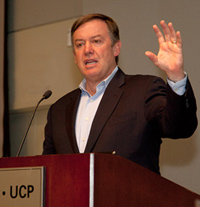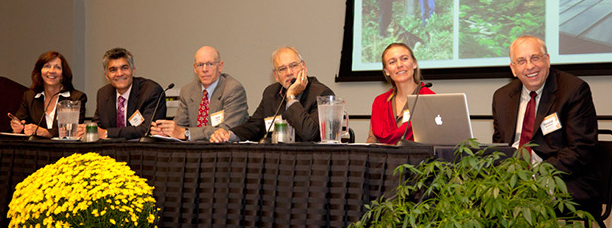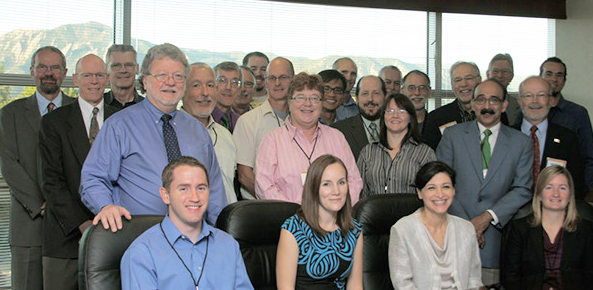Not your professor's degree
October meetings explore new curriculum options
Oct 21, 2011 - by Staff
Oct 21, 2011 - by Staff
Bob Henson | 21 October 2011 • Program consolidation, funding cuts, restless students: a sense of churn and uncertainty was palpable at this year’s meetings of UCAR member and affiliate representatives. But change can make room for innovation, and the 2011 meetings provided ample time for attendees to ponder the state of atmospheric science education and consider new approaches to teaching and training students.
The October meetings intersperse networking and organizational business (such as the election of members and trustees—see box below) with the UCAR Forum, which focuses attention on a pressing issue. Recent forums have emphasized the role of the UCAR community in making our nation more resilent to severe weather and a changing climate. Toward this end, it’s explored the roles of university-city partnerships (2009) and the use of science and art partnerships to better communicate climate and general science in the classroom and with the public (2010).
This year’s forum on workforce development segued into a daylong workshop, where roughly 40 faculty began to map out how alliances could help geoscience departments forge partnerships with other stakeholders on curricula and, perhaps, raise the visibility of their departments on their campuses. While this initial workshop was focused on curricula related to climate change and severe weather adaptation, participants expressed hope that such alliances could be used for a broad range of pressing community challenges. Such alliances might also help departments coordinate and strengthen programs in the face of growing demand for online options and multidisciplinary majors.

In his keynote talk, Arizona State University president Michael Crow discussed on ways to reinvent academia in the face of tight budgets.
The post-meeting workshop was an experiment, says Jack Fellows, UCAR vice president for corporate affairs: “By all accounts, it was very successful and allowed for a deeper level of discussion than is possible during the annual meeting.” Participants urged that a proposal be developed to provide both leadership and a mechanism to allow for the development and sharing of curricula related to weather/climate adaptation.
All of the week’s presentations can be viewed online through the meetings’ follow-up website.
Arizona State University president Michael Crow provoked lively dialogue at the forum with his keynote talk on how ASU coped with severe budget cuts, including a per-student drop in state funding of more than 55% over the last two years. Despite the cuts, he said, “we’re a stronger university than we were before.”
Shifting to a results-oriented perspective was critical, according to Crow. He outlined what he sees as academia’s emphasis on understanding (“A”) and its neglect of translation (“B”) and outcome (“C”). “The Vannevar Bush model of 1945 is still in place,” said Crow, referring to that scientific leader’s call for relatively unfettered federal support of basic research. Today, Crow said, “we honor the explanatory tool . . . but we do not honor solving for the outcome.”

Member representative Walter Robinson (North Carolina State University) makes a point at the UCAR Forum.
Crow cited ASU’s Institute of Global Sustainability as an example of an outcome-driven enterprise, designed to tackle such problems as a desert city needing to ensure its long-term water supply. It’s the kind of approach employed for many decades by land-grant universities, one audience member pointed out—though Crow noted that only a small fraction of national science funding now goes to land-grant schools
Forum attendees also watched and discussed a short TED video on the shifting landscape of higher education by journalist Anya Kamenetz, author of the books Generation Debt and DIY U. Students now wrestle with the soaring cost of an on-campus education (on the order of 1000% more expensive than it was in 1978) next to the ease of Web-based learning and the many low-cost options available online. Among a range of ideas, Kamenetz suggested that students might graduate with portfolios of their work rather than formal degrees and that they might build their own “personal learning networks,” a modern variant of the community-based apprenticeships employed worldwide for ages.
There’s no doubt that online education is booming. UCP’s COMET Program now has more than 600 hours of meteorological and related training accessed in more than 200 countries by more than 140,000 registered users. “We thought usership would plateau after a while, but it hasn’t,” said Joe Lamos, former deputy director of COMET.
Yet several forum participants wondered whether online-only courses challenge students enough to master the fundamentals of physics, math, or other building blocks to atmospheric science. The concerns were also discussed by faculty at bachelor’s-granting institutions in UCAR’s Academic Affiliates Program, which celebrated its 20th anniversary at this year’s meetings (see photo below). Many professors use COMET modules to supplement their in-person classes, and a number of programs provide courses and majors that are taught entirely online.

Panelists at the UCAR Forum and the subsequent alliance workshop included (left to right) Ginny Brown (National Council for Science and Education), Raj Pandya (UCAR), Jack Fellows (UCAR/UCP), Rich Clark (Millersville), and Dana Reinert (Kansas State University), and Don Wuebbles (University of Illinois).
Election results from the October meetings
New member from the Red River Valley: The University of North Dakota is now the 77th member institution of UCAR, following the approval of UCAR members at their Boulder meeting in October. UND’s Department of Atmospheric Sciences graduated its first Ph.D. student this summer, and the university was a founding member of the Academic Affiliate Program.
Trustees old and new: Roberta Balstad (Columbia University) and Fred Carr (University of Oklahoma) were both elected to second terms on the board as institutional trustees. Richard Clark (Millersville University of Pennsylvania) was elected for a second term as a trustee at large. Alan Robock (Rutgers University) and Everette Joseph (Howard University) are the new institutional trustees, and Vicki Arroyo (Georgetown Climate Center) is a new at-large trustee.
Changing of the committee guard: Below are new members for three important UCAR bodies. See links for more details on each group.
President’s Advisory Committee on University Relations (PACUR)
Simona Bordoni (California Institute of Technology)
John Braun (UCP)
Elizabeth Ritchie (University of Arizona)
Mike Wiltberger (NCAR)
Membership Committee
Nicole Mölders (University of Alaska Fairbanks)
Joe Zehnder (Creighton University)
Nominating Committee
Bill Easterling, chair (Pennsylvania State University)
Steve Ackerman (University of Wisconsin–Madison)
Susan Avery (Woods Hole Oceanographic Institution)
Eric Betterton (University of Arizona)
Everette Joseph (Howard University)
Kirk Maasch (University of Maine)
Sumant Nigam (University of Maryland)
Walt Robinson (North Carolina State University)
Alan Robock (Rutgers University)
At the same time, “you can’t replace the hands-on learning in an undergraduate meteorology class,” said Nolan Atkins (Lyndon State College). Tony Hansen (Saint Cloud State University) concurred: “You look into [a student’s] eyes and see, ‘Hey, he didn’t get it.’ You can’t do that online.”
Just as fluid as the modes of undergraduate teaching are the kinds of degrees being offered. A boom in students’ environmental interest and awareness is coinciding with a growing demand for practitioners to be well versed in a wide range of issues involving weather, climate, and society. How well do the new degrees meet the needs of the real world?
At the alliance workshop, participants grappled with many variables at play, including
At the University of Illinois at Urbana-Champaign (UIUC), Donald Wuebbles and colleagues blazed trails in 2007 by introducing an on-campus and online major in earth, society and environmental sustainability. Wuebbles and colleagues reached across disciplinary lines to build the new degree: for example, he said, “some agricultural faculty who were initially skeptical ended up developing joint courses with atmospheric scientists.”
The new UIUC degree dovetailed with faculty involvement with climate vulnerability assessments for the Midwest and the city of Chicago, among other clients. “Universities have a lot to offer to climate policy considerations,” said Wuebbles.
Local and regional interest is driving some programs. At Millersville University of Pennsylvania, an online master’s in emergency management is growing quickly. Students helped the nearby National Watch & Clock Museum develop a comprehensive disaster plan that’s now being implemented, said Millersville’s Richard Clark: “It was a very cool relationship.”
One way to build a discipline-crossing program is to join forces with other universities. Dana Reinert (Institute for Academic Alliances at Kansas State University) presented several models for such inter-institutional arrangements. In one such setup, mutually agreed-upon courses can be taught at one or more campuses at a common tuition rate, with a visiting student’s tuition divided among the host campus (80%), the student’s home campus (10%), and an administrative body (10%). Universities may opt to share courses without harmonizing entire degrees. Either way, a campus coordinator is crucial, said Reinert—“someone who’s resource-savvy, who knows how to get people engaged”—as is careful, collaborative implementation.
One suggestion emerging from the workshop was to use introductory environmental courses to help students decide what specialties might work for them and their strengths, especially for those hoping to transition from community college to four-year programs.
The challenges of studying the Earth in general, and weather and climate adaptation in particular, may not be for every student, but career paths continue to broaden. Clark noted that at least two atmospheric scientists now work for Mars, the manufacturing giant famous for M&Ms. He added that, in a world of just-in-time supply and weather/climate uncertainty, “you’d better make sure you know where your cocoa is coming from.”
At UCAR, Fellows and colleagues are very interested in hearing from the community on future topics for future annual meeting fora, particularly ones that represent pressing national and community issues. If you have suggestions, please email them to Jack Fellows.

The Academic Affiliates Program—founded to provide a voice within UCAR for institutions that have bachelor’s or master’s level programs in atmospheric science—recently toasted its 20th anniversary. In the photo above, UCAR managers join UCAR Academic Affiliate representatives and guests at their annual meeting in Boulder on 4 October.
Standing, left to right: Rick Anthes (UCAR president), Jack Fellows (UCAR vice president for corporate affairs), Joseph Zehnder (Creighton University), David Smith (U.S. Naval Academy), Oswaldo Garcia (San Francisco State University), Tony Hansen (Saint Cloud State University), Andrew Detwiler (South Dakota School of Mines and Technology), Nolan Atkins (Lyndon State College), Alison Bridger (San José State University), Duanjan Lu (Jackson State University), Rich Wagner (Metropolitan State College of Denver), Eric Hoffman (Plymouth State University), Redina Herman (Western Illinois University, in front), Richard Dixon (Texas State University, in back), Richard Mower (Central Michigan University), Rich Clark (Millersville University of Pennsylvania), Jose Maliekal (College at Brockport, State University of New York), Tom McElroy (York University), Michael Poellot (University of North Dakota), Andrew Oliphant (San Francisco State University).
Seated, left to right: Larry Hopper (University of Louisiana at Monroe), Anne Case Hanks (University of Louisiana at Monroe), Sepi Yalda (Millersville University of Pennsylvania), Gina Henderson (U.S. Naval Academy).